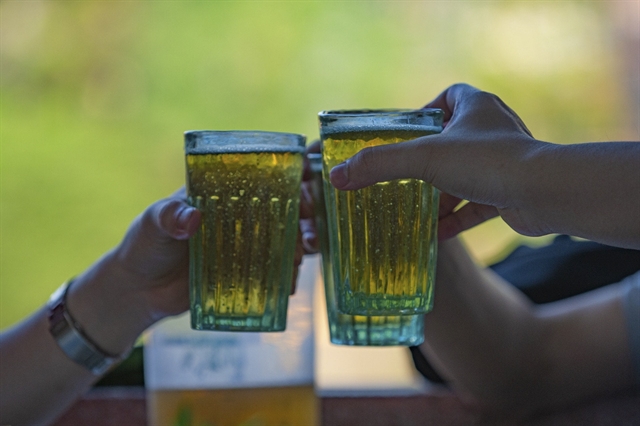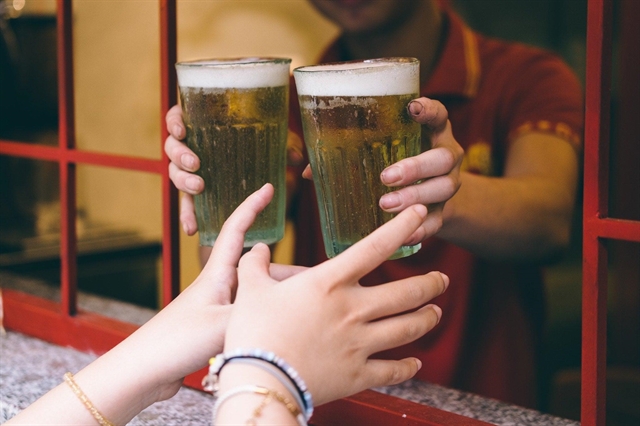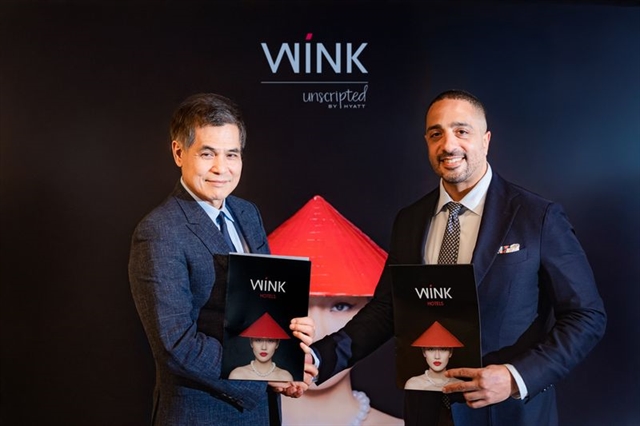 Life & Style
Life & Style

Lê Hương
Have you ever enjoyed bia hơi in Việt Nam? What do you think about the beer glass?
Few people know that the design is 50 years old. It was made by a modest designer, Lê Huy Văn, who would never imagine that his beer glasses would last for so long — and would continue as long as the bia hơi culture itself.
Few things scream Vietnamese as much as this iconic beer glass.
You’ll find them in bia hơi (fresh beer) bars the length and breadth of the country.
A cold beer on a hot day is an ideal way to cool down and relax after finishing work.
And there’s no mistaking the striking glass the bia hơi is served in.
Đỗ Quốc Thiện, a bia hơi shop owner in Dã Tượng Street, said he has been selling bia hơi since 1993.
"This glass has a unique feature that people don't want to replace," he told Việt Nam News. "It has come along with beer Hà Nội since cooperatives sold beer Hà Nội. This is a traditional feature of beer in Hà Nội. The interesting thing is that people keep the unique glass, which should not be something too luxurious, but not ordinary at the same time."
Thiện admitted that the glass is blown and made by hand by workers, so there are bubbles of air left on the glass, which is its most unique feature.
Nguyễn Hải Anh, a frequent bia hơi drinker, confessed that he drinks beer three times per week.
 |
| People drink beer to relax and bond. VNS Photo Đức Mạnh |
"Bia hơi is tasty to me," he said. "Bia hơi on the pavements is a feature of our culture. It must be this glass. If another model is used, it would better to go home than to drink beer."
Hải Anh said he thinks the glass design is very beautiful and suitable for drinking bia hơi.
"Drinking Hà Nội bia hơi should be out of this glass," he noted.
The glass was designed by Prof Lê Huy Văn, a former deputy rector of Hà Nội Industrial Fine Arts College who trained in engineering and art in Germany.
"I have done many good designs, but this beer glass design has lasted a long time," Văn said.
"Many people like it. That’s why it’s a deep memory. Many designs I like but people don’t like, or ideas that died soon after being born as there was fierce competition. My design may have been old right before it was launched, which is very difficult."
Văn was sent to Germany to study at a secondary school in Dresden in 1956, where he learned mechanical engineering. He returned to work at the Việt Nam Fine Arts Museum from 1962 to 1965, before studying industrial design at Design Burg Giebichenstein Fine Arts College in Halle until 1970.
In the 1970s, Văn returned to Việt Nam from Germany after his education.
He was assigned to work at an industrial handicraft cooperative for small productions.
"In 1975, after liberation, the demand for drinking beer appeared," Văn recalled.
"Hà Nội Beer Plant started to import machines from the Czech Republic to produce beer. At that time, there was nothing to drink except beer, which was new and luxurious. State staff and labourers entertained themselves with beer after work."
 |
| The beer glass design has lasted for dozens of years already. File Photo |
Originally glasses were bigger, so people didn’t have to queue over and over again for refills.
Văn's design is based on a Russian beer glass — but Văn gave it a very unique appearance.
As beer became more widely available, the size went down from 0.5 litres to just 0.33.
"I followed the theory of Bauhaus, which means good things are beautiful things, and the most practical one is aesthetics; i.e., the appearance should match the content," he said. "The design has value when it is produced on a mass scale."
The upper part of the glass is plain and the lower area has bumps to make it easier to hold.
It has been produced on a mass scale throughout the country since 1976.
"The glass has lasted for so long that it can be recycled," he said. "If it's broken, then people would recycle it. It's like a circle, which is my lucky symbol. My design is inside a spinning circle that never stops."
Văn has also designed the Sufat motorbike, a book binder and an ore sorting machine, which all have been produced on a mass scale. He has also co-written a lot of books in the fields of design and fine arts.
His defining principle is that his designs should be produced in mass numbers, with good quality and at reasonable prices.
 |
| Văn works in his study. VNS Photo Đức Mạnh |
The iconic glass drew the attention of Marcus Lacey, a British photographer living in Hà Nội. He mentioned Văn and his glass design in a chapter of his photo book, titled 'Food Odyssey Hanoi.'
"The reason I chose to include Mr Văn and the bia hơi glass in my book about Hà Nội food culture was that the glass and the experience of drinking from the glass is such a unique and amazing feature of drinking bia hơi, as well as being in Hà Nội and being with friends drinking on the streets," he said.
"Part of the experience and the uniqueness is the glass, because it's such a beautiful piece of design and is a wonderful part of the tradition of Hà Nội," he added.
Now in his 80s, Văn still designs and works with disabled children in various social enterprises like Vụn Art and Kim Việt.
But it’s this glass that will live on for many more years as an emblem of Việt Nam. VNS
 |
| Bia hơi with the iconic glass design is a part of Vietnamese culture. VNS Photo Đức Mạnh |

.jpg)


